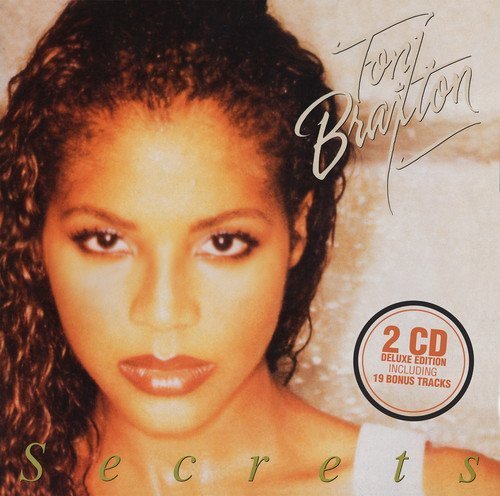From the king's palace to Little India and Chinatown, through the old European quarter and on to the beginnings of Bangkok's modern business district, a stroll down Charoen Krung Road touches nearly all of the historical-cultural threads that weave this fascinating city together. With eclectic food, bustling markets and a diverse mix of attractions, it's also a feast for the senses. Khao San and Sukhumvit roads may be better known to travellers, but nowhere is Bangkok's spirit more vivid than along Charoen Krung.
Granting the wishes of European merchants who requested thoroughfares suitable for horses, the road was built by order of King Rama IV in 1861 and roughly follows the path of the Chao Phraya River. In those days, Bangkok was tied together by canals and dirt paths, and Charoen Krung is thought to have been the city's first proper road. The 8.5 kilometre-long avenue was initially called "New Road", but Rama IV officially named it Thanon Charoen Krung -- "Road of the Prosperous City".
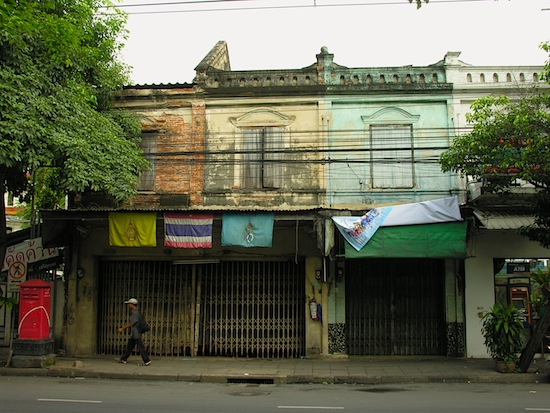
Get your walking shoes on.
Beginning where Charoen Krung emerges from near the back side of Wat Pho, we're captured first by the tranquility of Saranrom Royal Gardens. Continuing east, we duck into one of the many Old City alleyways and stride beneath strings of miniature Thai flags draped from one shophouse to the next.
We then come to Sala Chalermkrung Royal Theatre at the corner of Tri Phet Road. Commissioned by King Rama VII in the early 1900s, it's thought to have been the first cinema in Southeast Asia and continues to function as a performance space for a traditional khon mask troupe. Though Bangkok now boasts far flashier theatres, Sala Chalermkrung still has a magnetic presence.
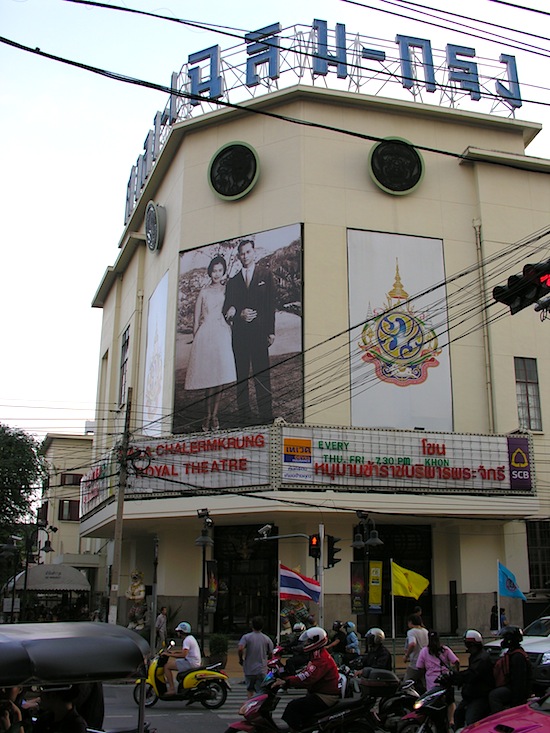
Sala Chalermkrung -- an enduring star.
A 100-metre sidetrack to the southwest and we find ourselves on Phahurat Road, the backbone of Bangkok's Little India. Although the Indian community has never been as large or noticeable as its Chinese counterpart, immigrants from the subcontinent have long played an important role in shaping the city. This legacy can be experienced today by wandering through the bright Indian textile shops that dominate the area.
Back on Charoen Krung, we cross a tiny canal bridge and have little choice but to join a stream of people who funnel below ground into what feels like the belly of Bangkok. In reality, it's Talaat Saphan Lek, one of the largest of many tightly packed markets found throughout Chinatown. We emerge from Saphan Lek only to lose ourselves again in the blinking, ticking and flashing displays of toy robots, clocks and karaoke machines in Khlong Thom and thieves' markets.
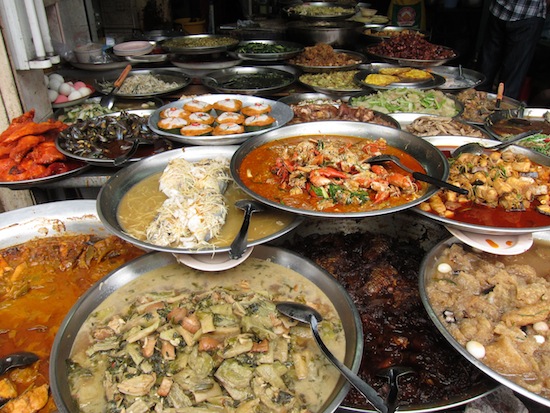
We doubt you'll go hungry around here.
Now in Chinatown proper, we're swept into the narrow alleys that connect Charoen Krung to Yaowarat Road. We maneouvre around human-powered push carts, over bushels of tea and under hanging fish heads along Soi Itsarunaphap. Just when the cramped quarters begin to overwhelm, we spot a single unoccupied table in a hole-in-the-wall shop, and in a flash, stacks of hand-made dim sum and steamed rice buns (sala bao) are at our fingertips.
After squeezing our way back to Charoen Krung, we pass Chinese bakeries, herb stores and open-fronted coffee shops where a late morning roomful of old men in loose slacks sit on plastic stools sipping their brew. Incense smoke wafts from Chinese shrines and mixes with the steam of footpath woks. We browse the melange of traditional Chinese calendars, Thai Buddhist amulets, weathered old knives and endless depictions of the Chinese goddess of compassion, Kuan Yin, in one of many antique shops.
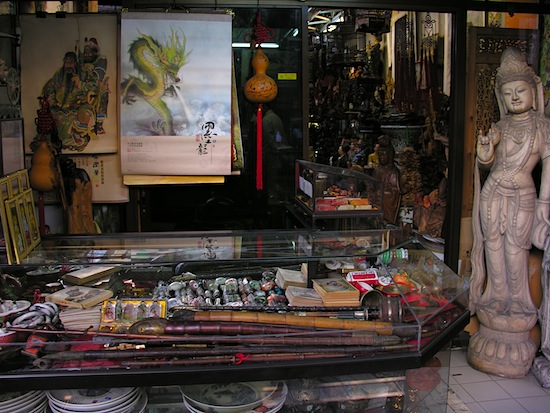
Where the locals go for souvenirs.
Most of the rundown yet still functional shophouses that line Charoen Krung were built by the hands of Chinese immigrants over a century ago. Many of the original businesses found within them are run by third or fourth generation descendents of the founders, keeping their humble family legacies in tact. Sadly, more than 40 of these heritage buildings were levelled in 2012 to make way for a new subway line that will eventually run beneath part of Charoen Krung.
Although the destruction of these historic houses is disheartening, and the future of the area uncertain, we find the old school flavour of Chinatown to be very much alive. Some of the most visible examples of this enduring spirit are the Pure Land Buddhist shrines perched along the footpaths of Charoen Krung.
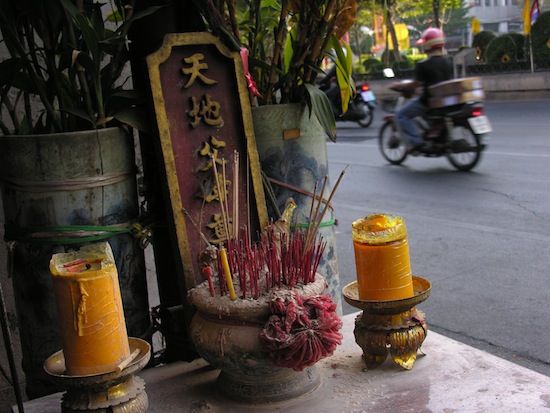
Keeping the fire burning.
A stone's throw further south and we kneel before two of Bangkok's most important religious images -- the solid gold Buddha of Wat Traimit and the twinkling Chao Mae Kuan Im. We pass through the gate of Chinatown at Odeon Circle, following Charoen Krung as it dips straight south and nearly bumps into Yaowarat Road near Hualamphong railway station.
The frenzy of Chinatown fades as we wade into the subtle beginnings of historic Bangrak. We pass narrow alleyways and charming old buildings -- apart from the roots of footpath banyan trees that grasp at open window sills, nothing appears to occupy some of them.
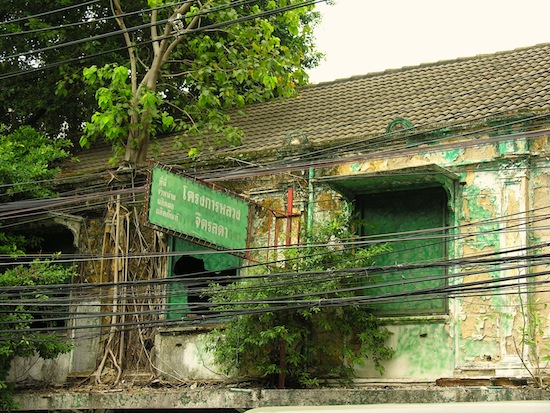
Charoen Krung's definition of treehouse.
We then come to several antique art galleries, jewellery and metal workshops on either side of the road. A wander into the Japanese built World War II warehouses down Soi 32 brings us to Fifty Years Gallery, home to an extraordinary collection of fine antique art from throughout Asia. Several more galleries are found further down Charoen Krung, including many in the beautifully restored OP Place on Soi 38.
Now firmly in what was once Bangkok's European quarter, we picture the well-heeled Westerners who once galloped their horses along the "New Road". Thanks in part to several riverside five-star hotels, the neighbourhood retains an upmarket feel. Although a handful of tourist-oriented travel offices and restaurants have been established, Charoen Krung never relinquishes its 'old Bangkok' atmosphere.
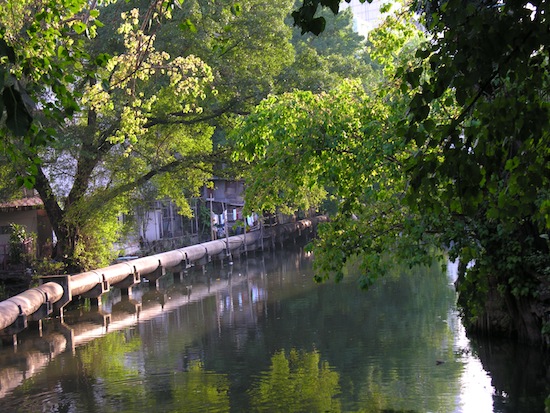
Padung Krung Kasem Canal -- one of many to criss-cross Charoen Krung.
In the vicinity of Assumption University off Soi 40, we take a seat on a pew in Romanesque-style Assumption Cathedral, the heart of Thailand's Roman Catholic community. Other architectural relics of the old European quarter include the original French and Portuguese embassies and the East Asiatic Building that once served as headquarters for the Danish freight company which helped turn Siam into an economic powerhouse around the turn of the 20th century.
Though several of this area's buildings are picturesque, we find none more captivating than the broken down old Customs Building at the end of Soi 36. With faded plaster walls, French-colonial style shutters hanging from broken windows and a reverent old clock tower that no longer ticks, the building sits by the river like an intentionally untouched tribute to a bygone era -- or the perfect setting for a horror movie. Rounding out the early 20th century nostalgic part of our Charoen Krung walk, we enjoy a more organised historical display at the Bangkokian Museum down Soi 43.
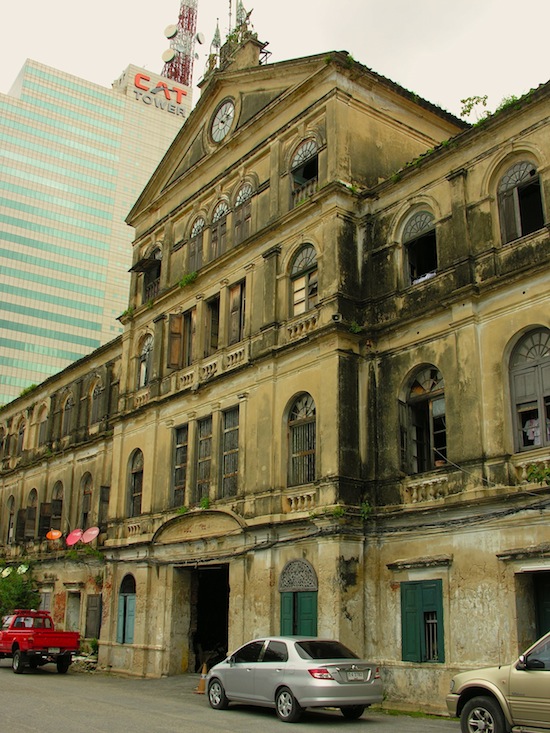
Who needs restoration?
This same area of Charoen Krung has also long been home to a thriving Muslim community, evidenced most visibly by Haroon Mosque across from the French Embassy. Although our bellies are still full of dim sum and Chinese tea cakes, we can't pass up the rich Thai-Indian-Muslim curries served on steel platters at 70 year-old Muslim Restaurant near Soi 42.
Further south, Charoen Krung once again grows livelier as it widens to meet Silom Road. Here we stumble on typical yet delicious Thai street fare to go with piles of tropical fruit in and around Soi 44. We also find old shophouses here, though they're now dwarfed by some of Bangkok's most behemoth buildings.
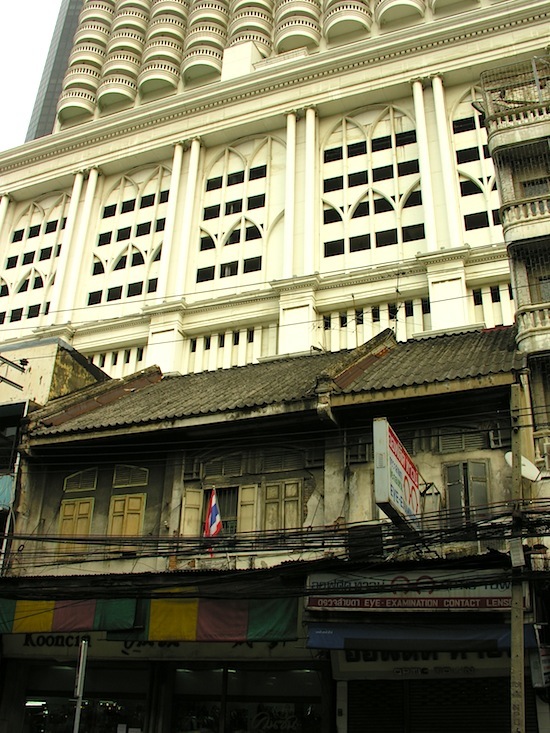
Old meets modern -- shophouses under the giant State Tower.
With a BTS skytrain station and Express Boat pier to our right and the bank headquarters of Sathorn Road shooting off to the left, we find ourselves beneath Saphan Taksin bridge. At nearby Wat Yannawa, we climb on the quirky temple hall built by Rama IV to resemble a Chinese trading junk. Across the street looms the "Sathorn Unique", a high-rise luxury apartment building left unfinished when developers ran short on cash following the 1997 Asia financial crisis.
From here, Charoen Krung mellows out once more and remains quiet over its last few kilometres. Though old shophouses continue to line the road, we're taken with some of the more modest residences that seem to make the most of what they have. Before heading back to the BTS station, we rest our feet and watch a fiery orange sun sink below the river from Bangkok's longest boardwalk at Asiatique night bazaar near Soi 74.
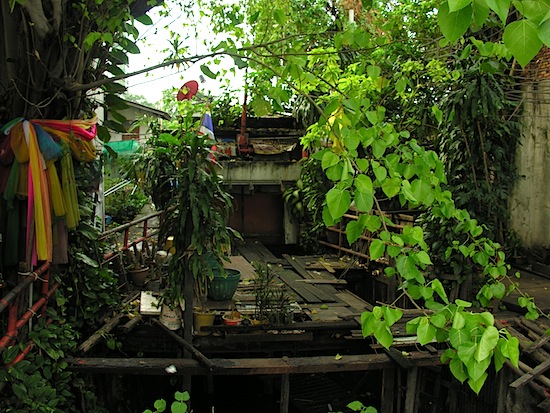
Someone's humble riverside escape.
Charoen Krung Road provides many glimpses into Bangkok's past, but it's also an example of the momentum that has carried the city forward. As we cruise above ground towards the malls and skyscrapers of central Bangkok, we reflect on how a tram car service that began running on Charoen Krung in 1894 must have been met by a similar excitement to that which energized the city when the skytrain first set sail in 2005. The very same momentum that brought Charoen Krung into existence 150 years ago continues to drive Bangkok towards a familiar idea -- prosperity.
Ready for a walk? Check out this map pinpointing the highlights of Charoen Krung.















